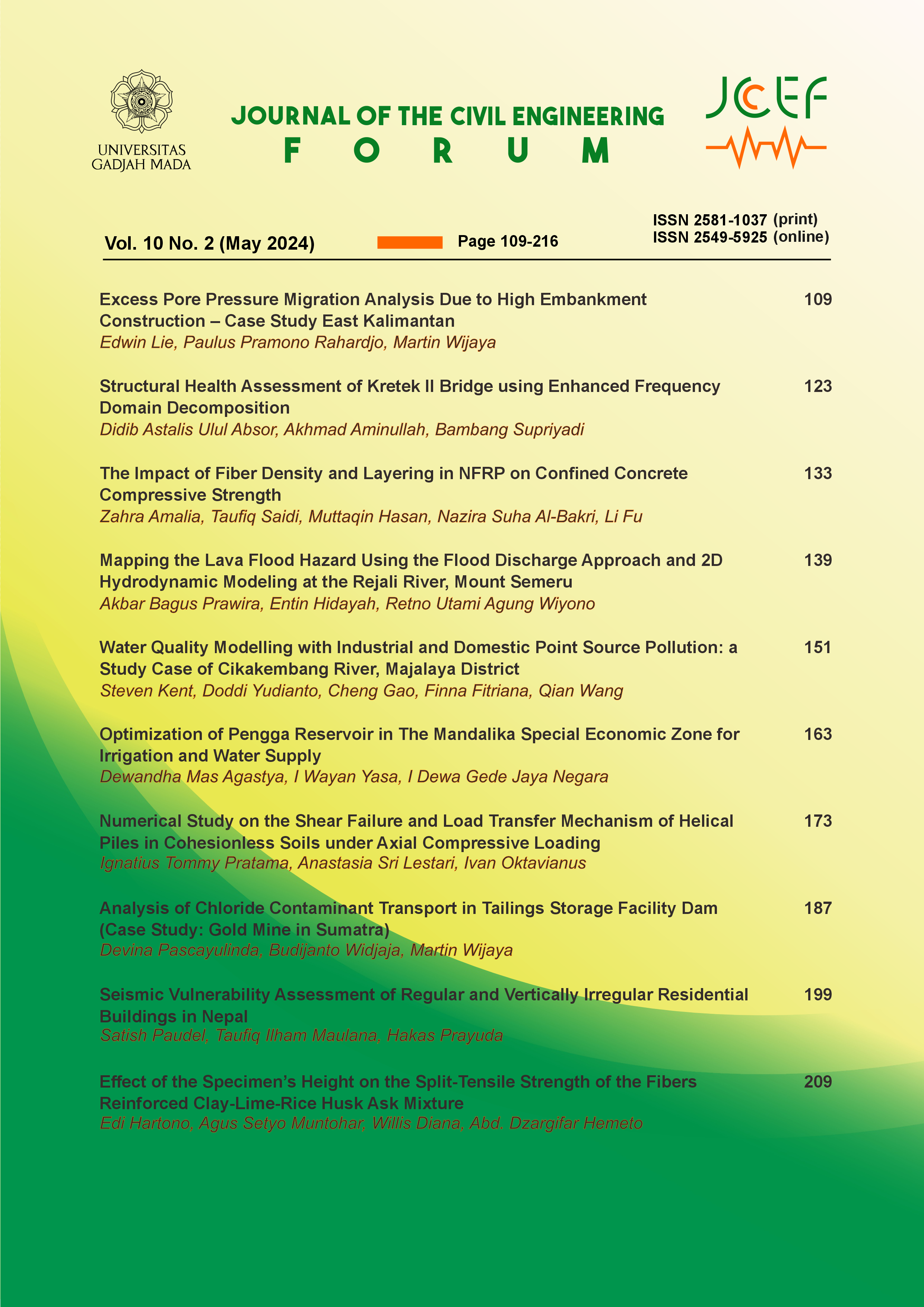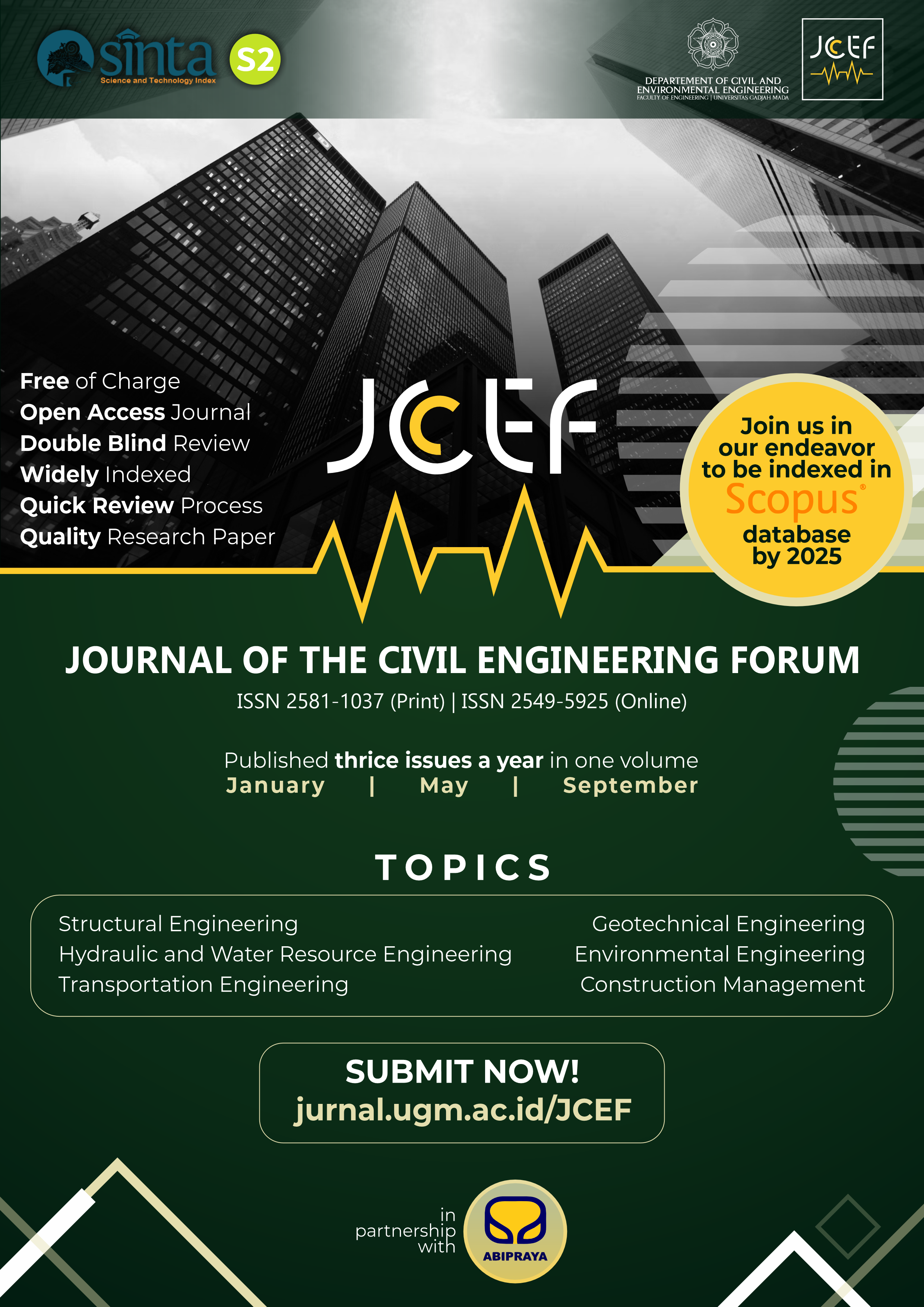Water Quality Modelling with Industrial and Domestic Point Source Pollution: a Study Case of Cikakembang River, Majalaya District
Abstract
Rapid industrial development is one of the leading causes of environmental degradation. The textile industries and the domestic activities in Majalaya District produce wastewater directly discharged into the Cikakembang River. As a result, the Cikakembang River’s water quality has decreased to the point that the water quality cannot be used for daily needs. This study modeled three main parameters in water quality modelling, namely Dissolved Oxygen (DO), Biological Oxygen Demand (BOD), and Chemical Oxygen Demand (COD). Using MATLAB, the three-water quality governing equations originating from the Advection-Dispersion Equation were solved using the Runge Kutte-4 discretization scheme. The numerical modelling was carried out along 2.36 km of the Cikakembang River. All water quality coefficients, such as the DO Saturation (DOsat), the Reaeration Rate (ka), the Dispersion Coefficient (D), the Deoxygenation Rate (kd), and the Decomposition Rate (kc), for the Cikakembang River were estimated using equations developed by existing studies. The estimation of ka and D coefficients requires hydraulic parameters, which in this study were estimated using the HEC-RAS simulation. Meanwhile, kd and kc values were obtained from the calibration and verification process. The Relative Root Mean Square Error (RRMSE) objective function was used to evaluate the results of water quality modelling at three sampling points. In the calibration process, the results
of water quality modelling produced RRMSE values for the DO, BOD, and COD parameters of 1.99%, 0.36% and 0.92%, respectively. Meanwhile, for the verification process, the RRMSE values for the DO, BOD, and COD parameters are 1.95%, 1.02% and 1.86%. All water quality parameters produce small RRMSE values in the calibration and verification processes. Hence, the water quality model created has good accuracy and stability.
References
Benedini, M. and Tsakiris, G. (2013), Water Quality Modelling for Rivers and Streams, Springer Dordrecht, s.l. URL: https://doi.org/10.1007/978-94-007-5378-3
Deng, T., Chau, K.-w. and Duan, H. (2021), ‘Machine learning based marine water quality prediction for coastal hydro-environment management’, Journal of Environmental Management 284, 112051. URL: https://doi.org/10.1016/j.jenvman.2021.112051
Despotovic, M., Nedic, V., Despotovic, D. and Cve tanovic, S. (2016), ‘Evaluation of empirical models for predicting monthly mean horizontal diffuse solar radiation’, Renewable and Sustainable Energy Reviews pp. 246–260. URL: https://doi.org/10.1016/j.rser.2016.11.064
Dey, S. and Islam, A. S. (2015), ‘A review on textile wastewater characterization in bangladesh’, Resources and Environment 5(1), 15–44. URL: https://doi.org/10.5923/j.re.20150501.03
Fitriana, F. et al. (2023), ‘The assessment of citarum river water quality in majalaya district, bandung regency’, Rekayasa Sipil 17(1), 37–46. URL: https://doi.org/10.14710/teknik.v17i1.45029
Haider, H., Ali, W. and Haydar, S. (2013), ‘Evaluation of various relationships of reaeration rate coefficient for modelling dissolved oxygen in a river with extreme flow variations in pakistan’, Hydrological Processes pp. 3949–3963. URL: https://doi.org/10.1002/hyp.9501
Iqbal, M. M., Shoaib, M., Farid, H. U. and Lee, J. L. (2018), ‘Assessment of water quality profile using numerical modeling approach in major climate classes of asia’, International Journal of Environmental Research and Public Health 15(2258). URL: https://doi.org/10.3390/ijerph15102258
Iwasa, Y. and Aya, S. (1991), ‘Transverse mixing in a river with complicated channel geometry’, Bulletin of the Disaster Prevention Research Institute 41 (3), 129–175. URL: https://doi.org/10.11408/suirikagaku.41.129
Jha, R., Ojha, C. S. P. and Bhatia, K. K. S. (2001), ‘Refinement a predictive reaeration equations for a typical indian river’, Hydrological Processes pp. 1047–1060. URL: https://doi.org/10.1002/hyp.122
Jha, R., Ojha, C. S. P. and Bhatia, K. K. S. (2004),‘A supplementary approach for estimating reaeration rate coefficients’, Hydrological Processes 18(1), 65–79. URL: https://doi.org/10.1002/hyp.1289
Khalish, M., Utami, A., Lukito, H. and Herlambang, S (2022), ‘Evaluation of textile industry waste water treatment as an effort to control river water pollution in central java’, KnE Life Sciences pp. 48–61.URL: https://doi.org/10.18502/kls.v8i1.10565
Lin, L., Yang, H. and Xu ,X.(2022),‘Effects of water pollution on human health and disease heterogeneity: A review’, Frontiers in Environmental Science 10. URL: https://doi.org/10.3389/fenvs.2022.846520
Liyanage, C. P. and Yamada, K.(2017),‘Impact of population growth on the water quality of natural waterbodies’, Sustainability 9(8), 1405. URL: https://doi.org/10.3390/su9081405
Menendez, A., Lecertúa, E., Badano, N. and García, P. (2016), ‘Numerical modeling to define remediation actions for water quality in streams’, Journal of Applied Water Engineering and Research pp. 67–81. URL: https://doi.org/10.1016/j.jaer.2016.03.004
Nasrollahi, Z., Hashemi, M., Bameri, S. and Taghvaee, V. M. (2020), ‘Environmental pollution, economic growth, population, industrialization, and technology in weak and strong sustainability: using stirpat model’, Environment, Development and Sustainability 22, 1105–1122. URL: https://doi.org/10.1007/s10668-019-00352-0
Nogare, M. A. and Bauer, B. O. (2022), ‘A field-based evaluation of the reliability of empirical formulae for quantifying the longitudinal dispersion coefficient in small channels’, geosciences 12(281). URL: https://doi.org/10.3390/geosciences12120281
Polisar, A. (2023), ‘Study of the impacts of domestic and textile industry wastewater discharge in cikakembang river, majalaya, bandung regency’, Parahyangan Catholic University. URL: https://doi.org/10.13140/RG.2.2.10236.33924
Popescu, I. (2014), Computational Hydraulics Numerical Methods and Modelling, IWA Publishing, London. URL: https://doi.org/10.2166/9781780404996
Schnoor, J. L. (1996), Environmental modeling: Fate and transport of pollutants in water, air, and soil, Wiley, Iowa. URL: https://doi.org/10.1002/9781119116469
Srinivas, T. A. S. et al. (2023), ‘Unlocking the power of matlab: A comprehensive survey’, IJARSCT 3(1), 20–31. URL: https://doi.org/10.47595/IJARSCT.2023.3710
Sun, L. et al. (2020), ‘A review of applications of fractional advection–dispersion equations for anomalous solute transport in surface and subsurface water’, WIREs Water. URL: https://doi.org/10.1002/wat2.1448
Tabari, H. (2020), ‘Climate change impact on food and extreme precipitation increases with water availability’, Scientific Reports 10, 13768. URL: https://doi.org/10.1038/s41598-020-70895-w
Tang, W. et al. (2022), ‘Twenty years of china’s water pollution control: Experiences and challenges’, Chemosphere p. 133875. URL: https://doi.org/10.1016/j.chemosphere.2022.133875
Wang, X., Jiang, J. and Gao, W. (2022), ‘Reviewing textile waste water produced by industries: characteristics environmental impacts, and treatment strategies’, Water Sci Technol pp. 2076–2096. URL: https://doi.org/10.2166/wst.2022.098
Wikiandy, N., Rosidah and Herawati, T. (2013), ‘The impact of textile industry waste pollution on damage to the structural organs of fish living in the upper section of the citarum river flow (das)’, Journal of Fisheries and Marine Affairs (Jurnal Perikanan dan Kelautan) pp. 215–225. URL: https://doi.org/10.14710/jpk.5.3.215-225
Worldwide, C. (2019), ‘Cdp global water report: Are companies responding to the risks and opportunities’, CDPWorldwide. URL: https://doi.org/10.46755/cdp.2019.011
Yan, B., Yu, F., Xiao, X. and Wang, X. (2019), ‘Ground water quality evaluation using a classification model: a case study of jilin city, china’, Natural Hazards 99 (2), 735–751. URL: https://doi.org/10.1007/s11069-019-03654-3
Yu, X., Shen, J. and Du, J. (2020), ‘A machine–learning based model for water quality in coastal waters, taking dissolved oxygen and hypoxia in chesapeake bay as an example’, Water Resources Research p. 56. URL: https://doi.org/10.1029/2020WR027227,
Zeng, Y. H. and Huai, W. X. (2014),‘Estimation of longitudinal dispersion coefficient in rivers’, Journal of Hydro-environment Research pp. 2–8. URL: https://doi.org/10.1016/j.jher.2014.05.001
Copyright (c) 2024 The Author(s)

This work is licensed under a Creative Commons Attribution-ShareAlike 4.0 International License.
Copyright is granted to authors for the purpose of providing protection for articles written to describe experiments and their results. JCEF will protect and defend the work and reputation of the author and are also willing to address any allegations of violation, plagiarism, fraud, etc. against articles written and published by JCEF. JCEF is published under the terms of the Creative Commons Attribution-ShareAlike 4.0 International License (CC BY-SA 4.0). The author holds the copyright and assigns the journal rights to the first publication (online and print) of the work simultaneously.




